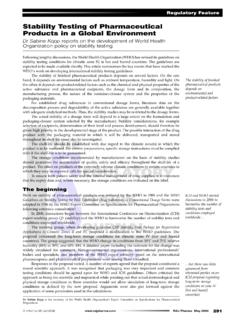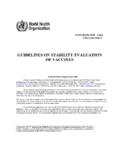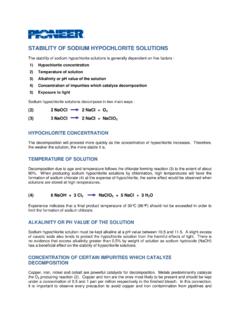Transcription of STABILITY – WHAT IS IT AND HOW DOES IT WORK?
1 STABILITY what IS IT AND HOW DOES IT WORK? Eastland . disaster, July 1915. STABILITY is the ability of a vessel to return to a previous position. Positive STABILITY would then be to return to upright and negative STABILITY would be to overturn. STABILITY in it's most ba- sic form is the relationship between the center of all floatation in your hull (center of buoyancy, or CB) and the center of all weight (vertical center of gravity, or VCG). In other words, the downward pull of Gravity and the uplifting force of Buoyancy. These are the primary charac- ters in this scene and all others play minor roles.
2 Once you understand how their relationship works, understanding STABILITY becomes a simple matter. Static STABILITY This is STABILITY at rest without active exter- nal forces at work. The VCG for all intended pur- poses is a fixed point in space and is a reflection of the placement of major weights within the boat af- fected in part by the amount of superstructure and number of decks. The shape of the hull determines the CB, which is not fixed. It moves around to balance the loads and keep the forces in equilibrium. The shape of the hull has a major effect on the path that the CB will take as the vessel heels or trims.
3 At rest the CB and the VCG align vertically. If they are not vertically aligned then the vessel will change trim or list until they do come into alignment. Then all the forces are equal- ized and the vessel becomes stable. Form STABILITY (effects of section shape). As the boat heels, sides of the boat previ- ously above water are immersed and bottom sec- tions previously underwater are now exposed, and the CB is on the move. The battle has begun. As forces are applied to the vessel changing it's atti- tude in relation to the surface of the water.
4 This causes the CB to move, creating the forces to bring the vessel into equilibrium. If the CB can not cre- ate enough counterforce to right the vessel then it will be over turned. The amount of counterforce can be determined mathematically from the designer's drawings and verified on the finished boat with an inclining experiment. How are these calcula- tions performed, you ask? Someone needs to do a weight calculation, which accounts for every item on the entire boat right down to the weight of the paint and screws, and also ac- counts for their position in the vessel both vertically and fore and aft.
5 Usually transverse meas- urements are considered less critical as most boats are very symmetrical. Knowing where the VCG is (remember, this is a fixed position) we can now go on to look at where the CB moves for each angle of heel. This is also calculated, but in a far more complex manner and is best done by and experienced Naval Architect (and their computer). Both hull form, and ballast if any, have a major role to play out in this scene. Both will have a major effect on STABILITY , but more on that later. Dynamic STABILITY Once a vessel is under way the effects of wave train, bottom pressure and change of trim can add or detract from the amount of STABILITY .
6 Many planing hulls become more sta- bile at speed due to the change in pressure distribution across the hull bottom. Because of the V-bottom and the spray rails outboard, unequal pressure builds up on the lower side in a turn. This pressure re- stores the vessel to upright when the heeling forces of the turn are over. Some double-ended vessels become less stable at hull speed because of the wave hollow amidship. With only the fine forward and after sections floating the boat and the Mid- ship section mostly unsupported there is little width to provide STABILITY .
7 This can also be a problem to any vessel in short steep seas. Active and passive stabilizer systems give the impression of increasing STABILITY ;. however they actually act to reduce roll. In fact, active stabilizers are only effective when underway. Amounts of STABILITY required The Coast Guard sets mini- mum standards of STABILITY for various types of commercial craft but no such standard is set for yachts. Fishing vessel standards can be used as a guide as they have similar characteris- tics and are a similar size to many off- shore cruising powerboats.
8 However, these are minimums and do not ad- dress comfort. And even comfort is subject to personal interpretation. A. serious offshore vessel will be tender initially and will tend to have a long easy rolling motion which will not knock crew nor gear off the deck. For many pleasure boaters this amount of roll and length of time (period of roll) is alarmingly long. If a boat is very stable at the dock (great as a liveaboard), or in flat water, it can have a very quick motion at sea. A case in point is a very successful 110 ft motoryacht that does har- bor charters seating 95 for dinner cruises.
9 When taken to sea it has such a quick motion in a seaway that the crew have to go around on their hands and knees to keep from getting knocked off their feet; and this is at 8 knots. Stepping aboard a 60 footer that noticeably settles under your weight (low GM) does not instill confidence. Having it heel under the press of a strong breeze will only erode that confidence further; yet it can have an excellent sea motion and be extremely comfortable once you get your sea legs. For the general boating public there has to be a middle ground.
10 Few boaters spend all their time at sea and just as few plan to spend all their aboard time at the dock (although sometimes it works out that way!). A compromise must be struck: one that provides STABILITY for dockside comfort moving around the vessel and a suitable motion for safe operation in some kind of seaway. The proportion of compromise depends on the purpose of the vessel and the market segment that it is appealing to. what is the intended use of the vessel and what level of experience will the purchaser have? Let's look at the effects various elements of design have on the STABILITY characteristics of a vessel.









